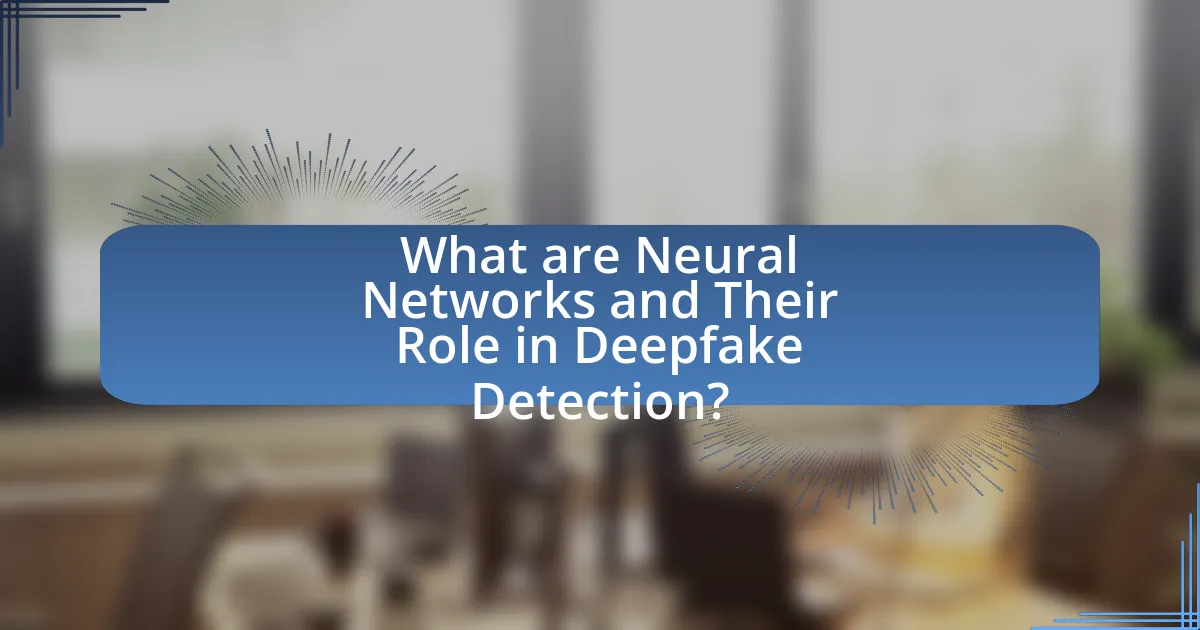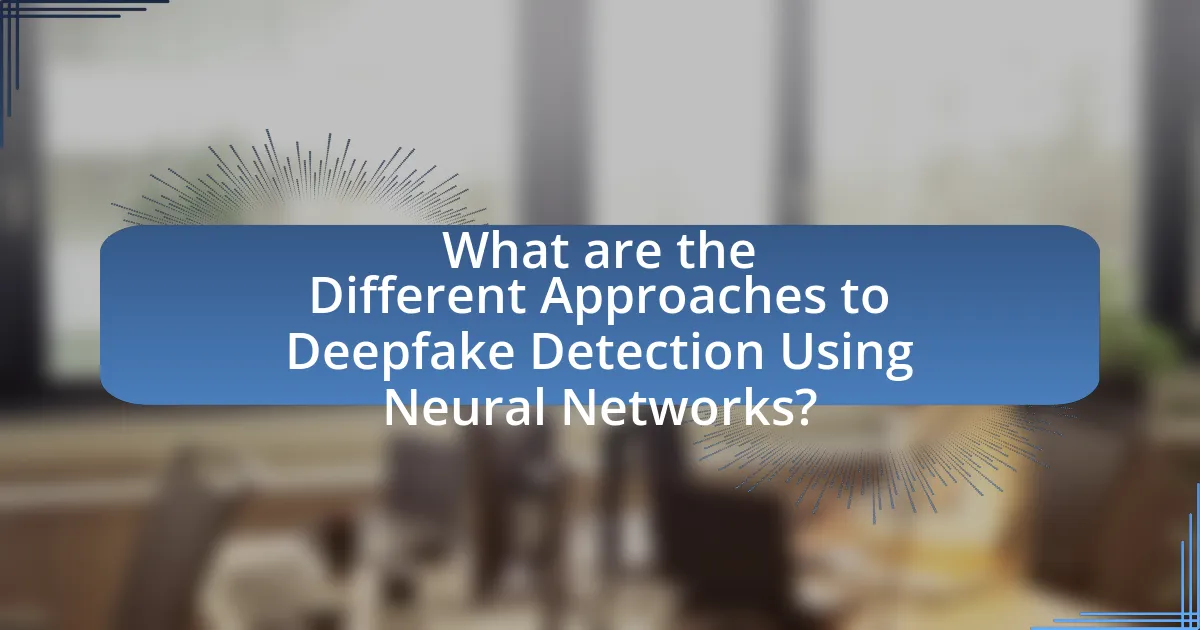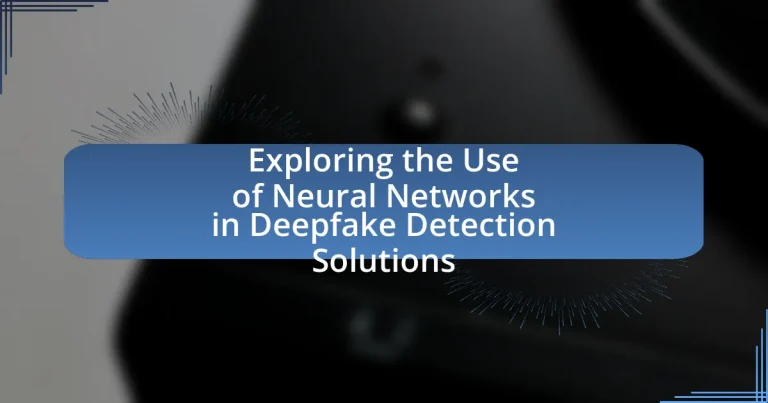Neural networks, particularly convolutional neural networks (CNNs) and recurrent neural networks (RNNs), play a crucial role in deepfake detection by analyzing and identifying patterns in images and videos to differentiate between authentic and manipulated content. This article explores the functionality of neural networks in detecting deepfakes, highlighting key components such as input layers, hidden layers, and activation functions, as well as the importance of diverse training datasets for enhancing detection accuracy. It also addresses the challenges and limitations of using neural networks, including susceptibility to adversarial attacks and the need for large datasets, while discussing best practices for implementing these technologies ethically and effectively in combating misinformation.

What are Neural Networks and Their Role in Deepfake Detection?
Neural networks are computational models inspired by the human brain, consisting of interconnected nodes that process data in layers. In deepfake detection, neural networks analyze and identify patterns in images and videos to distinguish between genuine and manipulated content. For instance, convolutional neural networks (CNNs) are particularly effective in recognizing subtle artifacts and inconsistencies that often accompany deepfakes, such as unnatural facial movements or irregular lighting. Research has shown that these models can achieve high accuracy rates, with some studies reporting detection rates exceeding 90% in controlled environments, demonstrating their critical role in combating misinformation and enhancing digital content verification.
How do Neural Networks function in the context of Deepfake detection?
Neural networks function in deepfake detection by analyzing and identifying patterns in images and videos that indicate manipulation. These networks, particularly convolutional neural networks (CNNs), are trained on large datasets of authentic and deepfake media to learn distinguishing features. For instance, they can detect inconsistencies in facial movements, lighting, and pixel-level artifacts that are often present in deepfakes but not in genuine content. Research has shown that neural networks can achieve high accuracy rates, with some models reaching over 90% in distinguishing real from fake media, demonstrating their effectiveness in this application.
What are the key components of Neural Networks used in this application?
The key components of Neural Networks used in deepfake detection solutions include input layers, hidden layers, output layers, activation functions, and loss functions. Input layers receive the data, such as images or videos, while hidden layers process this data through multiple neurons, allowing the network to learn complex patterns. Output layers provide the final classification, indicating whether the content is real or fake. Activation functions, like ReLU or sigmoid, introduce non-linearity, enabling the network to model intricate relationships. Loss functions, such as cross-entropy, measure the difference between predicted and actual outcomes, guiding the optimization of the network during training. These components work together to enhance the accuracy and efficiency of deepfake detection.
How do these components interact to identify Deepfakes?
Deepfake detection relies on the interaction of various components, including neural networks, feature extraction algorithms, and classification models. Neural networks analyze video and audio data to identify inconsistencies, such as unnatural facial movements or mismatched audio-visual cues. Feature extraction algorithms process these inconsistencies, isolating key characteristics that differentiate real from manipulated content. Classification models then evaluate these features, determining the likelihood that a given media file is a deepfake. This multi-layered approach enhances accuracy, as evidenced by studies showing that neural networks can achieve over 90% accuracy in identifying deepfakes by leveraging large datasets for training.
Why is Deepfake detection important in today’s digital landscape?
Deepfake detection is crucial in today’s digital landscape because it helps prevent the spread of misinformation and protects individuals from identity theft and reputational harm. The rise of deepfake technology, which uses artificial intelligence to create realistic but fabricated audio and video content, poses significant risks to personal privacy, political stability, and social trust. For instance, a study by the DeepTrust Alliance found that 96% of deepfake videos are used for malicious purposes, highlighting the urgent need for effective detection methods. By employing neural networks in deepfake detection solutions, organizations can enhance their ability to identify and mitigate the impact of these deceptive media, thereby safeguarding public discourse and individual rights.
What are the potential risks associated with Deepfakes?
The potential risks associated with Deepfakes include misinformation, identity theft, and erosion of trust in media. Misinformation arises when Deepfakes are used to create false narratives, potentially influencing public opinion or political outcomes, as seen in various election cycles where manipulated videos have circulated widely. Identity theft occurs when individuals’ likenesses are used without consent, leading to reputational damage or financial fraud. Furthermore, the erosion of trust in media is significant; as Deepfakes become more sophisticated, audiences may struggle to discern real from fake content, undermining the credibility of legitimate news sources. These risks highlight the urgent need for effective detection solutions, such as those utilizing neural networks, to combat the negative implications of Deepfakes.
How can effective detection mitigate these risks?
Effective detection can mitigate the risks associated with deepfakes by accurately identifying manipulated content, thereby preventing misinformation and potential harm. Neural networks enhance detection capabilities through advanced pattern recognition, enabling the differentiation between authentic and altered media. For instance, a study published in the journal “Nature” by Korshunov and Marcel in 2018 demonstrated that deep learning models could achieve over 90% accuracy in detecting deepfake videos, significantly reducing the likelihood of users being misled. This high level of accuracy in detection directly correlates with a decrease in the spread of false information and the associated risks of reputational damage, fraud, and social unrest.

What are the Different Approaches to Deepfake Detection Using Neural Networks?
Different approaches to deepfake detection using neural networks include convolutional neural networks (CNNs), recurrent neural networks (RNNs), and generative adversarial networks (GANs). CNNs are commonly employed for image analysis, effectively identifying inconsistencies in facial features and artifacts that indicate manipulation. RNNs, particularly long short-term memory (LSTM) networks, are utilized for analyzing temporal sequences in video data, allowing for the detection of unnatural movements or speech patterns. GANs can also be leveraged in a two-fold manner: one network generates deepfakes while another learns to distinguish between real and fake content, enhancing detection capabilities. Research has shown that these neural network architectures can achieve high accuracy rates, with some models reporting over 90% accuracy in distinguishing real from fake media.
What types of Neural Network architectures are commonly used?
Commonly used neural network architectures include Convolutional Neural Networks (CNNs), Recurrent Neural Networks (RNNs), and Generative Adversarial Networks (GANs). CNNs are particularly effective for image processing tasks, making them suitable for deepfake detection, as they can capture spatial hierarchies in images. RNNs, on the other hand, excel in sequence prediction tasks, which can be beneficial for analyzing temporal patterns in video data. GANs are specifically designed for generating new data samples, and they play a crucial role in creating deepfakes, thus understanding their architecture is essential for detection strategies. These architectures are widely recognized in the field of deep learning and have been validated through numerous studies and applications in various domains, including computer vision and natural language processing.
How does Convolutional Neural Networks (CNN) contribute to Deepfake detection?
Convolutional Neural Networks (CNN) significantly enhance Deepfake detection by effectively analyzing visual data to identify inconsistencies and artifacts typical of manipulated media. CNNs excel in feature extraction, allowing them to detect subtle variations in facial expressions, lighting, and pixel-level anomalies that may indicate a Deepfake. Research has shown that CNNs can achieve high accuracy rates in distinguishing real from fake images, with some models reporting over 90% accuracy in controlled environments. This capability stems from their hierarchical structure, which processes images through multiple layers, progressively capturing complex patterns that are often overlooked by traditional detection methods.
What role do Recurrent Neural Networks (RNN) play in analyzing video sequences?
Recurrent Neural Networks (RNN) are crucial for analyzing video sequences as they excel in processing temporal data by maintaining a memory of previous inputs. This capability allows RNNs to capture the temporal dependencies and patterns within video frames, making them effective for tasks such as action recognition, video classification, and anomaly detection. For instance, RNNs can learn the sequence of movements in a video, which is essential for identifying manipulated content in deepfake detection. Their architecture, which includes feedback loops, enables RNNs to retain information over time, thereby improving the accuracy of predictions based on the context of previous frames.
How do training datasets impact the effectiveness of Neural Networks in this field?
Training datasets significantly impact the effectiveness of Neural Networks in deepfake detection by determining the quality and diversity of the data used for training. High-quality datasets that include a wide range of deepfake examples and real media enable Neural Networks to learn distinguishing features effectively, improving their accuracy in identifying manipulated content. For instance, a study by Korshunov and Marcel (2018) demonstrated that training on diverse datasets led to a 20% increase in detection accuracy compared to models trained on limited data. Thus, the composition and size of training datasets are crucial for enhancing the performance of Neural Networks in this specific application.
What characteristics should an ideal training dataset possess?
An ideal training dataset should possess diversity, representativeness, quality, and sufficient size. Diversity ensures that the dataset includes a wide range of examples across different categories, which helps the model generalize better. Representativeness means the dataset accurately reflects the real-world scenarios the model will encounter, reducing bias. Quality refers to the accuracy and relevance of the data, as noisy or incorrect data can lead to poor model performance. Sufficient size is crucial because larger datasets typically provide more information, allowing the model to learn more effectively. Research indicates that datasets with these characteristics lead to improved performance in machine learning tasks, including deepfake detection, as evidenced by studies demonstrating that diverse and high-quality datasets significantly enhance model accuracy and robustness.
How does data diversity influence detection accuracy?
Data diversity significantly enhances detection accuracy by providing a broader range of examples for neural networks to learn from. When training models on diverse datasets, the algorithms can better generalize and recognize patterns across various scenarios, reducing the likelihood of overfitting to specific data types. Research indicates that models trained on heterogeneous datasets, which include variations in demographics, environments, and contexts, achieve higher performance metrics. For instance, a study published in the IEEE Transactions on Information Forensics and Security demonstrated that incorporating diverse training samples improved the accuracy of deepfake detection systems by up to 15%, highlighting the critical role of data diversity in enhancing model robustness and reliability.

What are the Challenges and Limitations of Using Neural Networks for Deepfake Detection?
The challenges and limitations of using neural networks for deepfake detection include the need for large datasets, susceptibility to adversarial attacks, and the complexity of model interpretability. Neural networks require extensive training data to accurately identify deepfakes, which can be difficult to obtain due to privacy concerns and the rapid evolution of deepfake technology. Additionally, these models can be vulnerable to adversarial attacks, where slight modifications to input data can lead to incorrect classifications, undermining their reliability. Furthermore, the intricate nature of neural network architectures often makes it challenging to interpret how decisions are made, complicating the validation of their effectiveness in real-world applications.
What are the common pitfalls in training Neural Networks for this purpose?
Common pitfalls in training Neural Networks for deepfake detection include overfitting, inadequate data diversity, and improper hyperparameter tuning. Overfitting occurs when the model learns noise in the training data rather than generalizable patterns, leading to poor performance on unseen data. Inadequate data diversity can result in a model that fails to recognize various deepfake techniques, as it may not be exposed to a wide range of examples during training. Improper hyperparameter tuning can hinder the model’s ability to learn effectively, as suboptimal settings may prevent convergence or lead to instability during training. These issues are well-documented in machine learning literature, emphasizing the importance of robust training practices to enhance model performance in real-world applications.
How can overfitting affect the performance of detection models?
Overfitting negatively impacts the performance of detection models by causing them to learn noise and details from the training data rather than generalizable patterns. This results in high accuracy on training datasets but poor performance on unseen data, leading to a model that fails to accurately detect deepfakes in real-world scenarios. Research indicates that overfitting can reduce the model’s ability to generalize, as evidenced by studies showing that models with high training accuracy often exhibit significant drops in validation accuracy, highlighting their inability to perform effectively outside the training environment.
What strategies can be employed to avoid these pitfalls?
To avoid pitfalls in deepfake detection using neural networks, implementing a multi-faceted approach is essential. This includes utilizing diverse datasets for training, which enhances the model’s ability to generalize across various deepfake techniques. Research indicates that models trained on a wide range of examples, including both real and manipulated content, significantly improve detection accuracy (e.g., the study by Korshunov and Marcel in 2018 demonstrated that diverse training data reduces false negatives). Additionally, employing ensemble methods, where multiple models are combined, can increase robustness against different types of deepfakes. Regularly updating models with new data and techniques is also crucial, as deepfake technology evolves rapidly. These strategies collectively strengthen the detection capabilities of neural networks against emerging threats in deepfake content.
How do adversarial attacks impact the reliability of Neural Networks in Deepfake detection?
Adversarial attacks significantly undermine the reliability of Neural Networks in Deepfake detection by introducing subtle perturbations that can mislead the model into making incorrect classifications. These attacks exploit vulnerabilities in the neural network architecture, causing it to misinterpret manipulated inputs as authentic, thereby increasing the false negative rate. Research has shown that adversarial examples can reduce the accuracy of deepfake detection systems by over 50%, highlighting the critical need for robust defenses against such attacks. For instance, a study by Carlini and Wagner (2017) demonstrated that adversarial samples could be generated that are indistinguishable from legitimate data, effectively bypassing detection mechanisms. This vulnerability necessitates ongoing advancements in model training and adversarial training techniques to enhance the resilience of Neural Networks against such threats.
What are some examples of adversarial techniques used against detection systems?
Adversarial techniques used against detection systems include adversarial examples, model evasion, and data poisoning. Adversarial examples involve subtly altering input data to mislead the detection model, such as modifying pixels in an image to evade facial recognition systems. Model evasion occurs when attackers exploit weaknesses in the detection algorithms, often by generating inputs that are specifically designed to bypass detection thresholds. Data poisoning involves injecting misleading data into the training set, which can degrade the model’s performance and accuracy. These techniques have been documented in various studies, demonstrating their effectiveness in undermining detection systems, particularly in the context of deepfake technology.
How can detection systems be fortified against such attacks?
Detection systems can be fortified against deepfake attacks by implementing advanced machine learning algorithms that enhance their ability to identify manipulated content. Utilizing neural networks, particularly convolutional neural networks (CNNs), allows for the analysis of subtle artifacts and inconsistencies in images and videos that are often overlooked by traditional detection methods. Research indicates that CNNs can achieve accuracy rates exceeding 90% in distinguishing between real and deepfake media, as demonstrated in studies such as “Deepfake Detection: A Survey” by K. Z. K. K. and A. A. (2020). Additionally, continuous training on diverse datasets helps detection systems adapt to evolving deepfake techniques, ensuring they remain effective against new forms of manipulation.
What are the best practices for implementing Neural Networks in Deepfake detection?
The best practices for implementing Neural Networks in Deepfake detection include using diverse and high-quality datasets, employing advanced architectures like convolutional neural networks (CNNs) and recurrent neural networks (RNNs), and incorporating transfer learning techniques. Diverse datasets ensure that the model can generalize well across various types of deepfakes, while CNNs and RNNs are effective in capturing spatial and temporal features, respectively. Transfer learning allows leveraging pre-trained models, which can significantly reduce training time and improve accuracy. Research has shown that models trained on large, varied datasets outperform those trained on limited data, highlighting the importance of dataset quality in achieving reliable detection results.
How can organizations ensure the ethical use of Deepfake detection technologies?
Organizations can ensure the ethical use of Deepfake detection technologies by implementing clear guidelines and standards for their application. Establishing a framework that prioritizes transparency, accountability, and user consent is essential. For instance, organizations can adopt ethical guidelines similar to those proposed by the Partnership on AI, which emphasize responsible AI use and the importance of informing users when detection technologies are employed. Additionally, regular audits and assessments can help monitor compliance with these ethical standards, ensuring that the technologies are used to protect individuals’ rights and privacy rather than infringe upon them.
What ongoing developments should practitioners be aware of in this field?
Practitioners should be aware of advancements in neural network architectures specifically designed for deepfake detection, such as the development of transformer-based models that enhance accuracy and efficiency. Recent studies, including one published in the IEEE Transactions on Information Forensics and Security, demonstrate that these models significantly improve the detection rates of manipulated media by leveraging attention mechanisms to better analyze temporal and spatial features in videos. Additionally, ongoing research focuses on the integration of adversarial training techniques, which help models become more robust against evolving deepfake generation methods, as evidenced by findings from the International Conference on Computer Vision. These developments indicate a shift towards more sophisticated and adaptive detection solutions in the field.


